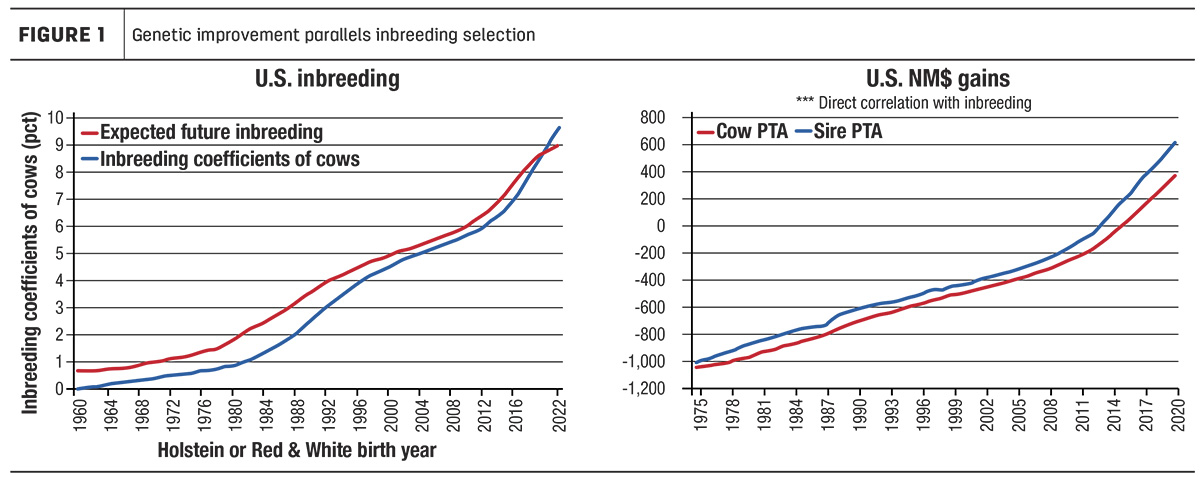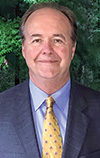Inbreeding indicates the degree of homozygosity at a locus within a population. Normally inbreeding is estimated in terms of a coefficient calculated from the pedigree of an individual. If no history is available, or data on individuals are missing, there is no way to estimate the inbreeding coefficient.
Dare we say our normal estimation method could use some improvement? We express inbreeding through an archaic methodology completely ignoring today’s technology, which indicates the degree of homozygosity at a locus.
Inbreeding is thought to be a big problem. But is it? Let’s begin with some takeaways Council on Dairy Cattle Breeding (CDCB) geneticists Kristen Parker Gaddis and Rodrigo Mota, technical adviser Duane Norman and past intern Fiona Guinan made at the Managing Genetic Diversity for Future Dairy and Livestock Breeding, American Dairy Science Association (ADSA) Discover Conference, March 2022:
- Geneticists around the world are working hard to answer the question of how we maintain the same rate of genetic progress without concern for potential future consequences of higher inbreeding.
- Inbreeding levels have been increasing over the past few decades. While this is a situation that must be monitored, there have not been signs of serious inbreeding depression.
- In the meantime, the CDCB and USDA are actively monitoring any potential new genetic defects that may affect our cattle population.
These three statements are worth examining.
First, “the CDCB and USDA are actively monitoring any potential new genetic defects that may affect our cattle population.” For the record, inbreeding does not cause genetic defects. Mutations cause genetic defects. Inbreeding creates the opportunity for the discovery of mutations (both new and old) and their genetic effects. Our increased inbreeding over time has brought forth the discovery of multiple recessive genes and given them an opportunity to express themselves. Not all the known recessives in our dairy population are deemed deleterious – take red Holsteins, for example. Recessives that are deemed harmful – once discovered thanks to inbreeding – can be selected against and eliminated from the population. (Can you say mule foot or limber leg?)
Secondly, what are the concerns of scientists over future consequences of inbreeding while maintaining genetic progress? Most of us immediately think of a range of possible economic losses from lost pregnancies to deformed calves. And yes, breeding carriers to carriers creates the opportunity for homozygous deleterious matings of existing harmful recessives to occur, incurring a financial loss. None of us want that. Prior to genomics, pedigree data – assuming pedigree information was available and accurate – was our only real tool. Even then, we often didn’t really know if the animals being mated were actual carriers or not. Hence, the formulation currently in place in our official CDCB Predicted Transmitting Abilities (PTA) where each additional potential 1% increase in pedigree inbreeding from a sire relative to the base population carries a regression factor utilized to reduce that sire’s published PTA for each trait published (Table 1).

Thirdly, “There have not been signs of serious inbreeding depression.” So, does that mean so far so good, and that we’ve been playing with fire, but surely, we are soon to be severely burned? Let’s look at what we know.
U.S. Holstein pedigree inbreeding increases from genetic selection
You can see from Figure 1 that inbreeding of U.S. Holsteins and the genetic gain we have experienced here in the U.S. are in parallel with each other. (We see the same trend for Jerseys and colored breeds as well). Therefore, it is safe to say that without selecting for the genes we wanted and putting them into our population, the U.S. would not be the world’s leading supplier of Holstein genetics. Might we even say inbreeding has been our friend?

It is understandable that when pedigree information was our only available tool, the degree of unknown variables being used created a sense of insecurity, that we were operating in the dark, unsure how far we could push the envelope of inbreeding. Hence, our current regression factors have been in place to "protect" against possible inbreeding losses and are now becoming archaic in their methodology.
But what about variation? Genetic diversity is required for genetic progress. Have we lost sufficient variation in traits for continued progress, and have we plateaued from our continued inbreeding and there are no remaining outlying genes left to integrate into our populations?
Is continued genetic improvement of livestock sustainable?
One presenter during ADSA's conference referenced William Hill, who said: “Large genetic improvements in the quantitative traits of growth, production and efficiency of farmed livestock have been made over recent decades, and with the introduction of genomic technology, these are being enhanced. Such continued improvement requires that there be available variation to utilize. The evidence is that little variation has been lost, and that such rates are indeed sustainable in the future.”
The heritability of lactation milk yield in dairy cattle has risen from 25% in the 1950s to 35% currently, likely partly due to improved management.
Consistent with steady rates of improvement relative to the mean, the coefficients of variation (CV), and therefore evolvabilities (coefficients of variation divided by the mean), of growth traits in meat species and of milk yield in dairy cattle also seem to have remained fairly constant. Notwithstanding over 50 generations of intense selection, commercial populations have maintained additive genetic variation in important traits.
Should inbreeding be avoided?
No, not if we want to keep breeding elite animals and keep our current rate of genetic progress. Inbreeding is almost unavoidable without a severe slowing in genetic progress. Yes, mutations exist. However, selection for desired genes does allow discovery of mutated and undesirable genes, which once discovered allows opportunity for isolation and eradication of those newly discovered deleterious genes.
The homozygosity of the "good" genes separates the top performing genes from the inferior genes, including for lower heritability traits such as Somatic Cell Score (SCS), Productive Life (PL), Livability (LIV), Daughter Pregnancy Rate (DPR), Cow Conception Rate (CCR), Heifer Conception Rate (HCR), Sire Calving Ease (SCE), Daughter Calving Ease (DCE), Fertility Index (FI), Sire Stillbirth (SSB), Daughter Stillbirth (DSB), Residual Feed Intake (RFI) and going forward for mastitis, metritis, ketosis, gestation length (GL), retained placenta (RP), displaced abomasum (DA), milk fever (MF) and lameness.
Today we understand that homozygosity is the key to genetic progress. Homozygosity is the very definition of inbreeding and having the genomic tools to avoid deleterious homozygosity in favor of additive homozygosity is an improved method.
References omitted but are available upon request by sending an email to the editor.






